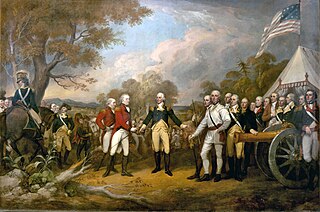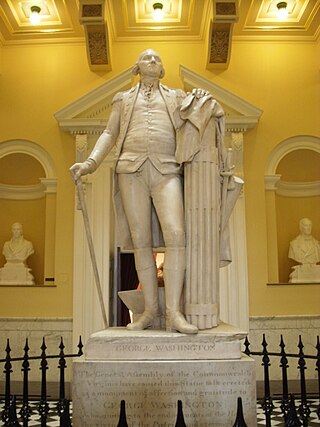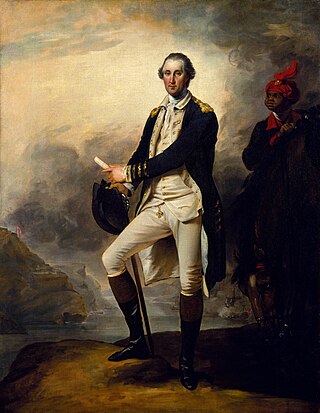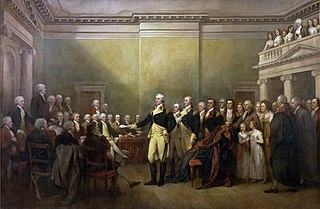
Thomas Mifflin was an American merchant, soldier, and politician from Pennsylvania, who is regarded as a Founding Father of the United States for his roles during and after the American Revolution. Mifflin signed the United States Constitution, was the first governor of Pennsylvania, serving from 1790 to 1799, and was also the state's last president, succeeding Benjamin Franklin in 1788.

John Trumbull was an American artist of the early independence period, notable for his historical paintings of the American Revolutionary War, of which he was a veteran. He has been called the "Painter of the Revolution".

The Maryland State House is located in Annapolis, Maryland. It is the oldest U.S. state capitol in continuous legislative use, dating to 1772 and houses the Maryland General Assembly, plus the offices of the Governor and Lieutenant Governor. In 1783 and 1784 it served as the capitol building of the United States Congress of the Confederation, and is where Ratification Day, the formal end of the American Revolutionary War, occurred.

Scene at the Signing of the Constitution of the United States is a 1940 oil-on-canvas painting by Howard Chandler Christy, depicting the Constitutional Convention signing the U.S. Constitution at Independence Hall in Philadelphia on September 17, 1787. Along with Washington Crossing the Delaware by Emanuel Leutze, the painting is one of the most famous depictions of the early days of the United States. Christy created the painting in April 1940; it is so large that he painted it in a sail loft. It currently is displayed along the east stairway in the House of Representatives wing in the Capitol building.

Eleazer McComb was an American merchant from Dover, Delaware. He was a delegate from Delaware to the Continental Congress from March 1783 until January 1784. He moved to Wilmington, Delaware in 1792 and died there in December 1798.

The United States Capitol rotunda is the tall central rotunda of the United States Capitol in Washington, D.C. It has been described as the Capitol's "symbolic and physical heart". Built between 1818 and 1824, the rotunda is located below the Capitol dome, which was built between 1857 and 1866.

Declaration of Independence is a 12-by-18-foot oil-on-canvas painting by the American artist John Trumbull depicting the presentation of the draft of the Declaration of Independence to Congress. It was based on a much smaller version of the same scene, presently held by the Yale University Art Gallery. Trumbull painted many of the figures in the picture from life, and visited Independence Hall to depict the chamber where the Second Continental Congress met. The oil-on-canvas work was commissioned in 1817, purchased in 1819, and placed in the United States Capitol rotunda in 1826.

The Surrender of General Burgoyne is an oil painting by John Trumbull. The painting was completed in 1821 and hangs in the United States Capitol rotunda in Washington, D.C.

The Surrender of Lord Cornwallis is an oil painting by John Trumbull. The painting, which was completed in 1820, now hangs in the rotunda of the United States Capitol in Washington, D.C.

George Washington is a statue by the French sculptor Jean-Antoine Houdon from the late 18th century. Based on a life mask and other measurements of George Washington taken by Houdon, it is considered one of the most accurate depictions of the subject. The original sculpture is located in the rotunda of the Virginia State Capitol in Richmond, Virginia, and it has been copied extensively, with one copy standing in the United States Capitol Rotunda.

Joseph Wright was an American portrait painter and sculptor. He painted life portraits of George Washington and Benjamin Franklin, and was a designer of early U.S. coinage. Wright was President Washington's original choice for Chief Engraver of the U.S. Mint, but died at age 37, before being confirmed to that position.

George Washington, also entitled George Washington and William Lee, is a full-length portrait in oil painted in 1780 by the American artist John Trumbull during the American Revolutionary War. General George Washington stands near his enslaved servant William Lee, overlooking the Hudson River in New York, with West Point and ships in the background. Trumbull, who once served as an aide-de-camp to Washington, painted the picture from memory while studying under Benjamin West in London. He finished it before his arrest for high treason in November. The portrait, measuring 36 in × 28 in, is on view in Gallery 753 at the Metropolitan Museum of Art in New York City. Originally in the possession of the de Neufville family of the Netherlands, it was bequeathed to the museum by Charles Allen Munn in 1924.

The Death of General Mercer at the Battle of Princeton, January 3, 1777 is the title of an oil painting by the American artist John Trumbull depicting the death of the American General Hugh Mercer at the Battle of Princeton on Friday, January 3, 1777, during the American Revolutionary War. The painting was Trumbull’s first depiction of an American victory. It is one of a series of historical paintings on the war, which also includes the Declaration of Independence and The Capture of the Hessians at Trenton, December 26, 1776.

The Capture of the Hessians at Trenton, December 26, 1776 is the title of an oil painting by the American artist John Trumbull depicting the capture of the Hessian soldiers at the Battle of Trenton on the morning of Thursday, December 26, 1776, during the American Revolutionary War. The focus is on General George Washington aiding the mortally wounded Hessian Colonel Johann Gottlieb Rall. Nearly 900 Hessians were captured at the battle. It is one of Trumbull's series of historical paintings on the war, which also includes the Declaration of Independence and The Death of General Mercer at the Battle of Princeton, January 3, 1777. The painting is on view at the Yale University Art Gallery in New Haven, Connecticut.

General George Washington at Trenton is a large full-length portrait in oil painted in 1792 by the American artist John Trumbull of General George Washington at Trenton, New Jersey, on the night of January 2, 1777, during the American Revolutionary War. This is the night after the Battle of the Assunpink Creek, also known as the Second Battle of Trenton, and before the decisive victory at the Battle of Princeton the next day. The artist considered this portrait "the best certainly of those which I painted." The portrait is on view at the Yale University Art Gallery in New Haven, Connecticut, an 1806 gift of the Society of the Cincinnati in Connecticut. It was commissioned by the city of Charleston, South Carolina, but was rejected by the city, resulting in Trumbull painting another version.

Washington at Verplanck's Point is a full-length portrait in oil painted in 1790 by the American artist John Trumbull of General George Washington at Verplanck's Point on the North River in New York during the American Revolutionary War. The background depicts the September 14, 1782 review of Continental Army troops Washington staged there as an honor for the departing French commander Comte de Rochambeau and his army.

George Washington's resignation as commander-in-chief marked the end of Washington's military service in the American Revolutionary War and his return to civilian life at Mount Vernon.

The Death of General Montgomery in the Attack on Quebec, December 31, 1775 is an oil painting completed in 1786 by the American artist John Trumbull. It depicts American general Richard Montgomery at the Battle of Quebec during the invasion of Quebec. The painting is on view at the Yale University Art Gallery in New Haven, Connecticut. It is the second in Trumbull's series of national historical paintings on the American Revolutionary War, the first being The Death of General Warren at the Battle of Bunker's Hill, June 17, 1775.

George Washington was a life-size marble statue of George Washington, done in the style of a Roman general, by the Italian Neoclassical sculptor Antonio Canova. Commissioned by the State of North Carolina in 1815, it was completed in 1820 and installed in the rotunda of the North Carolina State House on December 24, 1821. The building and the statue were destroyed by fire on June 21, 1831. This work was the only one created by Canova for the United States.

George Washington is a large full-length oil painted by American artist John Trumbull in 1790.


























